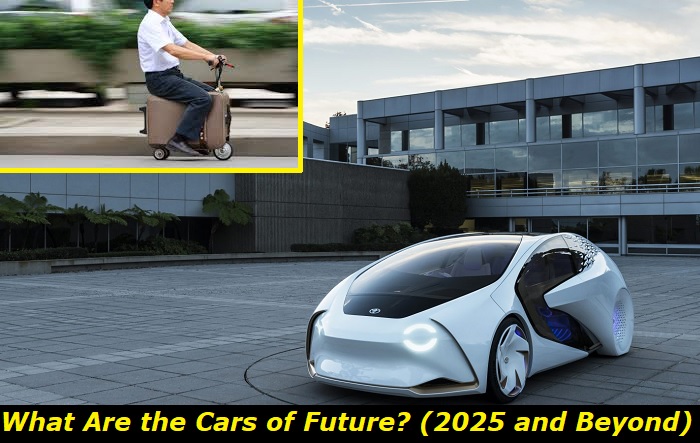The future is coming to us so fast that we just don't have time to notice all the changes. A couple of years ago, driving an EV was something very unusual. New electric vehicles were seen as concept cars and only appeared rarely on the roads. Now, if you don't have an EV, your neighbors are looking at you with pure surprise in their eyes. The future is coming.
But what are the trends in the passenger car industry? What are we going to get in two or three years? What about ten years after now? Today, we'll tell you how we see the trends in the car industry and what we expect to happen after 2025 and beyond.

Let's get started!
1. Electrifying will grow immensely
Electric cars are not our future anymore. They are our reality. All powerful brands gave up developing ICE technologies and are now diving purely into the electric vehicle industry. Have you seen a new gasoline engine that a well-known brand invested a lot of money in being released within a year or two? No! Companies stopped investing in gasoline and diesel technologies.
The only possible bridge between gas and electricity that will still be OK after 2025 is hybrid technology. But even those powerplants are going to be dying in a couple of years and moving away from the market to let EVs take over.
We see that electrifying trends are getting stronger and stronger, so we don't know what can change that. Experts expect that by 2030, EVs will have more than 70% of car sales in the world. And there are experts who say that 100% of sold new cars will be EVs in 2035.
2. Autonomous driving - one of the mainstreams
We see that Tesla is not the only company implementing autopilots (although a little limited but still autopilots) in their cars. Lots of luxury brands are developing their adaptive cruise control technologies to basically make them autopilots.
We expect that after 2025, most new vehicles in rich trims will have something like an autopilot. Autopilots will work in a combination of factors like GPS data, the system of road cameras, vehicle cameras, sensors, etc. They will become much safer than just human-controlled driving and will gradually take over driving.
We expect autonomous driving to be a normal thing after 2030.
3. Simplification of design concepts
We now see that many brands gave up creating beautiful and branded cars that they needed to invest millions and even billions of dollars to create. Brands tend to simplify their design concepts to make all their models look the same and just be of different sizes and have different technologies onboard.
Look at modern Volvo cars - they all look the same. They just have different body types and different shapes but their design is just the same which saves a lot of money for the brand.
We believe the design of vehicles will become less and less important. But the technologies onboard will be the key feature for a buyer to choose between different models.
4. AI implementation
Artificial intelligence will certainly change the way the car industry works. Companies will inevitably launch new production lines under the control of AI and will use AI for car design, technology development, etc. They will also implement AI models directly in the interior of your vehicle.
Passenger cars will become smarter and will be certainly integrated with an internet connection. Just like your smartphone, they will not be able to work without proper internet traffic.
Although this may seem like a drawback, you will get a lot of perks with this. Your future car will answer your questions, self-diagnose, explain and implement road rules in different states and countries, get information on road conditions, etc.
5. Sustainable materials are the new trend
Nasty plastic in your interior and heavy metal body parts will most likely go into the past in just a decade or so. We need to stop using natural resources, especially those that are not renewable, to make cars. This is one of the problems with EVs because they still use a lot of metals for their batteries that are hard to mine and they cause a lot of bad impact on nature.
After 2025, the sustainability trend will be the main tendency in car building. We will see new materials that are biodegradable and can be recycled. Actually, but 2035, we expect that an average passenger car will be 100% recyclable.
Of course, this will affect the durability of vehicles. Most likely, we will drive new cars for about 7 years and then will have to give them away for recycling and buy new ones.
6. New financial programs for new cars
We see that American, European, and Chinese financial programs are working more or less OK to keep the average age of cars in those territories much younger than in other countries. So, we expect the world will come up with new, even more convenient, financial programs so that people could afford to buy a new car every 5 or 7 years and then just give it away for recycling.
We expect that leasing programs will be changed so that leasing companies will earn less or will get compensation from governments. But it's important to motivate people to buy newer vehicles and to get rid of old cars that are not sustainable and not nature-friendly.
7. Changing the model of car ownership
Currently, the majority of people own their cars. They buy them after paying the leasing contract or buy them with loans. Some of us buy cars for cash. We believe, after 2025, the nature of car ownership will start changing. We will move to something like renting a vehicle when we need it.
More and more cars will not be owned by a certain person. Instead, you will be able to come to a huge parking, get a car when you need it and pay for hours, days, or maybe miles that you drive. After that, you will be able to leave the vehicle in one of the hundreds of other parking lots all around the country.
We need this change to reduce the traffic congestion on streets in the cities and to move from private transport to public transport models, especially in big cities.
8. EVTOLs revolution
We see that air taxis or EVTOLs are developing very fast and in 2025 some companies are going to launch their first projects with real air taxis.
In short, these are big passenger quadrocopters that are able to take off and land vertically. They will take you from point A to point B in the city for just several minutes instead of a couple of hours in a traditional taxi or your own car.
These EVTOLs are all electric and sustainable. And you may think this is a far future of transportation, but no. Airbus, Delta, American Airlines, NASA, and dozens of other well-known companies are investing now to open their first routes using air taxis in 2025-2030.
9. Shift to public transport in some areas
We've been to Europe and we were surprised with how cool the public transport works in the cities. You can easily get from one edge of the city to a completely different suburb for 20-30 minutes without even starting your car. Just jump from one bus to another and change it to a trolleybus at the needed stop and you are there.
It's not going to work in all cities of the US because of the specific features of private house areas. But it's going to work in big cities and we believe local authorities will make efforts to reduce the number of private cars and taxis on the road in cities.
10. Smart systems of transportation
Cars may be included in smart city concepts that are now being developed in numerous cities all around the world. The smart city is a system that controls all the aspects of city life electronically. So, basically, there are thousands of cameras all over the city and they are connected to one system operated by AI models.
These systems can also connect to future cars and tell them what to do to avoid traffic jams or potential accidents. These cameras and AI models can analyze traffic and prevent collisions and other problems on the roads.
But for these, future cars need more smart technologies onboard. And we are afraid this will change the price for future vehicles.
Final thoughts
Please keep in mind that all these 10 trends that we've mentioned above are based on the current tendencies in the world of passenger cars. We perfectly know that something will change once some company develops the new technology and this will turn the world of cars into a completely new direction.
But based on what we know now, we can surely say that this is one of the most probable scenarios where the car industry will be slowly moving within the next few years. Of course, not all of these technologies will be available after 2025. We'll need some time to master them and to find the possibility to implement them in every single vehicle.
About the authors
The CarAraC research team is composed of seasoned auto mechanics and automotive industry professionals, including individuals with advanced degrees and certifications in their field. Our team members boast prestigious credentials, reflecting their extensive knowledge and skills. These qualifications include: IMI: Institute of the Motor Industry, ASE-Certified Master Automobile Technicians; Coventry University, Graduate of MA in Automotive Journalism; Politecnico di Torino, Italy, MS Automotive Engineering; Ss. Cyril and Methodius University in Skopje, Mechanical University in Skopje; TOC Automotive College; DHA Suffa University, Department of Mechanical Engineering






Add comment